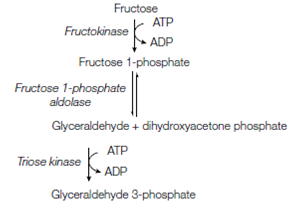Metabolism of fructose:
Fructose is an abundant sugar in the human diet; sucrose (table sugar) is a disaccharide that when hydrolyzed yields glucose and fructose and fructose is also a main sugar in honey and fruits. There are two pathways for the metabolism of fructose; one occurs in muscle and adipose tissue and the other in liver.
1. In adipose and muscle tissue, fructose can be phosphorylated through hexokinase (that is capable of phosphorylating both glucose and fructose) to form fructose 6-phosphate that then enters glycolysis.
2. In liver, the cells hold majorly glucokinase instead of hexokinase and this enzyme phosphorylates only glucose. Therefore in liver, fructose is metabolized instead through the fructose 1-phosphate pathway shown in the figure.
- Fructose is transformed to fructose 1-phosphate through fructokinase.
- Fructose 1-phosphate is then split into glyceraldehyde and dihydroxyacetone phosphate through fructose 1-phosphate aldolase. The dihydroxyacetone will feeds into glycolysis at the triose phosphate isomerase step.
- The glyceraldehyde is phosphorylated through triose kinase to glyceraldehydes 3-phosphate and so also enters glycolysis.

Figure: The fructose 1-phosphate pathway.